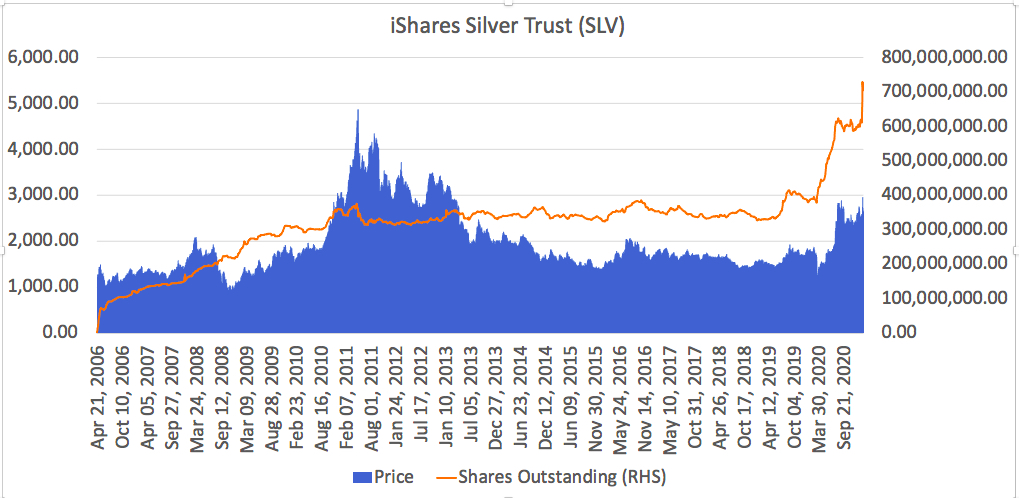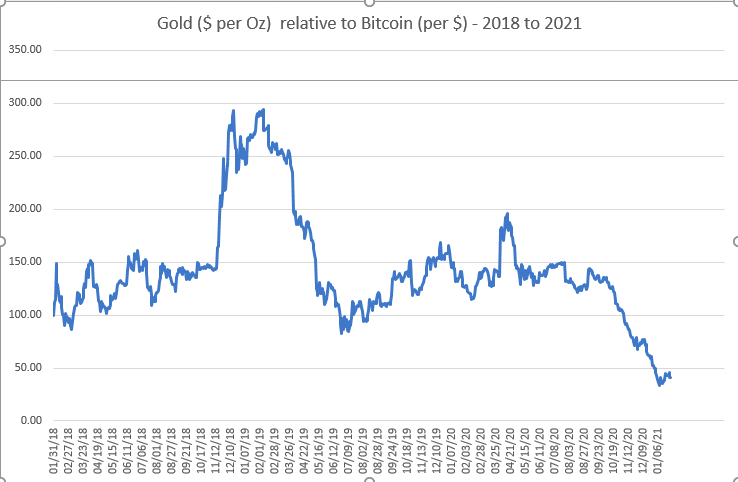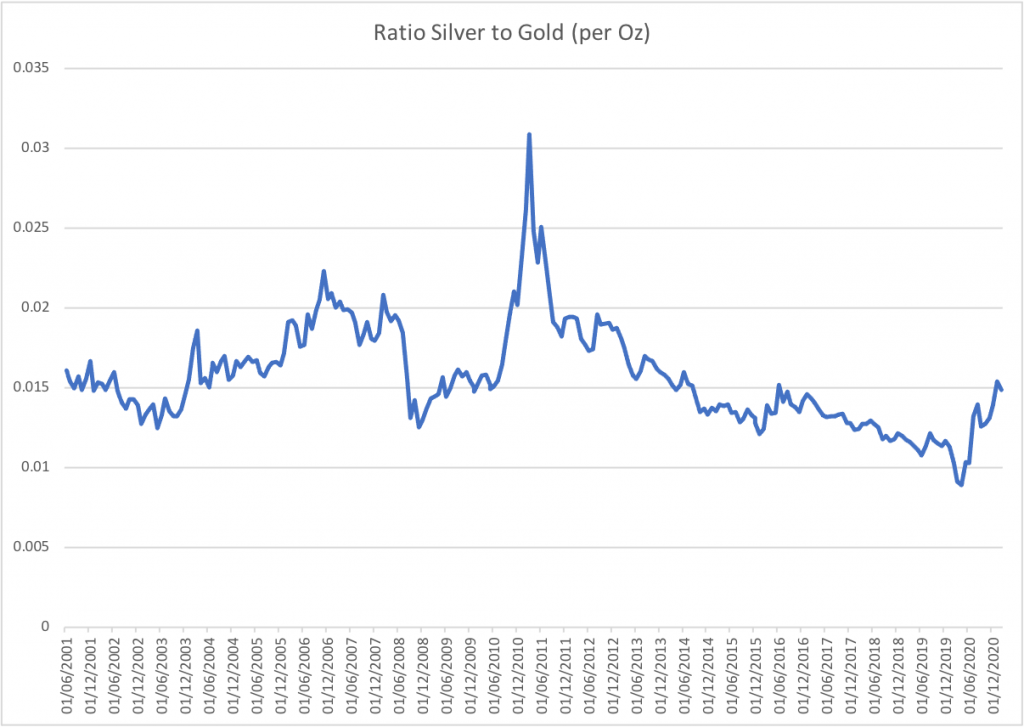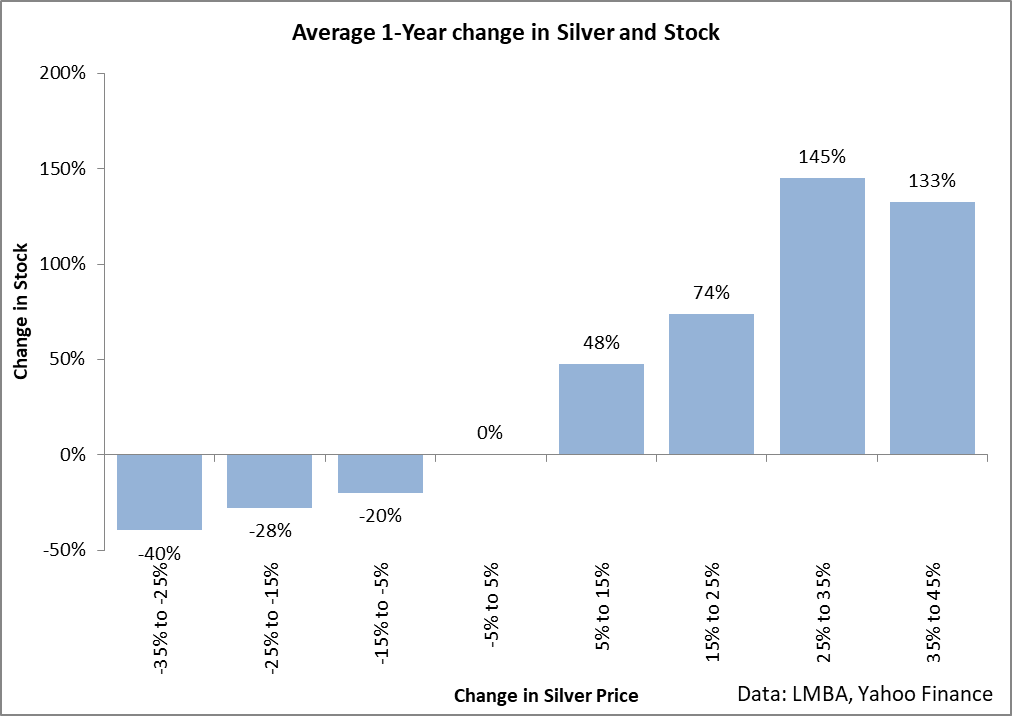Silver is a commodity that has never been short of spectacular stories and rallies. In 1980 the Hunt brothers tried to corner the silver market causing it to rally 7 fold in 1 year. Many years later, at the time of the failure of Bear Stearns in 2008, commodity markets were abuzz with stories that JP Morgan (the acquirer of Bear Stearns in the Great Financial Crisis) was suppressing the price of silver as they had inherited a significant short silver position – a precious metals trader eventually pleaded guilty to such many years later. From 2008 to 2011 silver rallied 4 fold. Rest assured, silver is a part of the market that has never lacked drama!
Fast forward 13 years, and the #silversqueeze is being discussed again on social media in the context of the latest market focus on short positions. Prior to the recent retail trading media frenzy, we noted how precious metals and Bitcoin looked compelling and we wanted exposure to such under our Inflation Series in December 2020. Bitcoin rocketed in subsequent weeks, so in our January outlook piece we referenced how attractive silver and gold looked relative to Bitcoin.
Subscribe for stock updates as they are published – The Collective Finance
For a number of days in January silver and $SLV got caught up in the frenzy and market chaos around Robinhood and Reddit. In the last week this looks to have subsided with Gamestop, Blackberry, Nokia and other chatroom favourites having reverted to more normal levels. However, we wanted to revisit silver as we believe the fundamental case is strong and that retail speculation could return.
In this piece, The Collective will articulate the fundamental case for an extended silver rally and, in particular, the major beneficiary of such – the silver mining stocks. We now add the junior silver miners ETF ($SILJ) as a recommendation within the Inflation Series. We see 100% upside in $SILJ on a 1 to 2 year view meeting our return criteria.
The fundamentals of silver
The beauty of silver versus Bitcoin and gold is not just its precious metal scarcity status but also its applications in industry. Each year approximately 50% of the silver produced goes into industrial applications like auto manufacturer and solar panels. The balance is used within jewellery, coin production, photography and, importantly, into ETFs and ETPs (exchange traded products used by investors and portfolio managers) that are backed by physical bullion.
Our fundamental view is that in a fiscal and monetary driven recovery, post lockdown, the usage of silver is going to increase with overall GDP and industrial activity. In addition, investor demand will continue to increase as an inflation hedge. This demand will exceed the annual supply, which of course means much higher prices.
We believe we are at the beginning of an extended bull run in silver (and gold) which have both underperformed Bitcoin. You can read our top down view for the inflation series here http://The next Chapter: From the “Lockdown Series” to the “Inflation Series”. Commodities, precious metals, value stocks and, yes, digital currencies…
The imbalance in silver supply and demand. Lets dig into some numbers…
Each year we mine and produce approximately 1 billion ounces of silver. Where does it all go? Here are some figures from 2020:
- 475mn ounces to industry
- 260mn ounces to jewellery, silverware and photography
- 215mn ounces to physical investment and coins.
What this means is that prior to investors buying ETFs the market is pretty balanced in terms of production meeting demand most years (full history below).
In the last 10 years silver prices have never done anything too radical i.e like 2008 to 2011 or 1979 to 1980 respectively where they rallied 4x and 7x respectively. However that could change as there is a growing elephant in the room – the exchange traded market and ETFs like SLV.
Recent weeks are showing a growing investor appetite coming back that could really shift silver demand at a time when mining production has been impacted (COVID hit production in 2020). The explosion in ETF interest and silver (and gold) coin buying seems to be increasing every month since March 2020 and this has taken a significant step higher in recent weeks.
On the physical coin side, the US Mint could not meet demand for silver and gold coins in 2020 and through January https://www.theguardian.com/business/2021/feb/03/us-mint-couldnt-meet-demand-for-gold-and-silver-coins-due-to-pandemic-buying
If people can’t get hold of coins they may simply just buy a physical backed ETF. The purchasing of silver via exchange traded products is significant and growing. Chart 1 shows the growing shares outstanding in the iShares Silver Trust ($SLV) – the largest direct silver ETF.
If you look at the information from the Silver Institute, 2020 finished with the largest market imbalance in recent history. This could get a lot more severe if the recent demand from the silver ETFs keeps increasing.
Full detail here on silver supply and demand: https://www.silverinstitute.org/silver-supply-demand/
Could retail investors move the silver market?
A direct silver ETF owns the physical silver, usually held by a custodian on its behalf, and issues shares against it. Such ETFs closely track the day-to-day movement in silver prices – this is superior to physical product as buying physical silver involves additional costs related to commissions, transportation, and storage.
While an ETF holding silver has these costs, the expenses are divided among all the shareholders, which effectively lowers the cost of investment for an individual investor. As the ETF does have to cover costs – it allocates around $0.93 of each $1 invested to physical bullion. The SLV ETF (the far largest) does not entitle you to get delivery of physical silver but the ETF is backed by silver in a vault. You can easily buy and sell ETF units through your brokerage account like stocks.
In January 2021 alone we saw an increase in the SLV shares outstanding by 100 million from 600 million. 100 mn shares of the SLV equates to $2.6bn of purchases which could mean approximately 93mn of ounces – that is 10% of the world production in 2020 had to go into a vault in theory in 4 to 5 weeks!

How significant could investor interest in silver become? According to the Silver Institute report, the net demand from ETF products was 120mn ounces in 2020. At $26 per ounce that equates to $3bn of net demand from exchange traded products in 2020.
This is still very small compared to the amount allocated to Bitcoin. Without going into full detail – only 21 million units of Bitcoin will ever be produced and there are currently around 19 million coins valued at $730bn at current prices..
If 2.5% of Bitcoin assets rotated into Silver that would be almost $20bn of investor demand. That would equate to 770mn ounces of demand! Last year we saw 120mn ounces of net investor demand which was part of the move in the the silver price from $17 to $26. This would be 6 times that amount.
What does all this mean? We could only be the beginning of the silver run. The selling down of Bitcoin, movement of cash and government cheques to $SLV within a Revolut, DeGiro or Robinhood trading app is very straightforward.
The COMEX short position
Separate to the ETF and physical silver market, COMEX is a commodity exchange that allows industrial and financial traders to trade silver futures. This means that people can take views on future silver prices and hedge production of silver. What certain commentators have noted over the last decade is that there are a group of 4 very large short positions on COMEX and obviously for these entities a large price increase in silver would be detrimental.
What is interesting, it would appear, is that in the last week the short positions within this group have increased and may have been a factor in keeping a lid on silver prices despite the explosion in retail/ETF interest last week.
How big are these short positions? Will they ever cover? It would appear that these large short positions shorted a further 6,600 future contracts, bringing their position to 65,000 contracts short. This equates to 330mn ounces of silver – as we noted above this is 1/3 of the annual production. This is significant and this is top 4 positions only. The monitoring of these short position warrants attention in the reports from the COMEX and Commitment of Trader reports – a move by these to cover would be significant.
How does silver compare to Bitcoin and Gold?
As mentioned, Gold is attractive relative to Bitcoin and Silver is attractive relative to Gold in terms of historical ratios. Chart 2 shows Gold relative to Bitcoin (which we are not chasing here – there will be better levels – and bitcoin does not have industrial applications) and Chart 3 shows how Silver has underperformed Gold versus its normal ratio over 20 years. Now looks a compelling time to increase your allocation to Silver relative to Gold and Bitcoin versus recent and long term history.


Why silver miners versus silver?
In a silver bull run, the mining stocks display more ‘upside beta’ than the commodity price – see chart 4. Mining companies have operating leverage than drives their earnings as the silver price moves higher i.e their $ received for mined silver moves higher versus their operating costs. Future company earning expectations are therefore increasing faster than the actual silver price and mining share prices anticipate such.
There are lots of mining ETFs out there, but the junior silver miners ETF is interesting as it has the benefit of being diversified within smaller silver (and gold) mining companies. In essence between operating leverage of the mining companies and the small cap effect – it is very high beta. The ETF holds around $750 million in AUM. You can see full details here of the ETF https://etfmg.com/funds/silj/ . You will own a diversified fund of mining stocks without taking any major single name risk.

How much could $SILJ rally?
Lets keep this simple – if there is large imbalance in the market with growing investor and industrial demand (noting that production from mines fell in 2020) – prices will go higher.
How high? We do not believe that it is wrong to suggest that silver prices could get back to their 2011 highs of $46 from $27 currently. Gold has already reached its 2011 levels in the last 6 months and silver will follow.
Silver to Gold ratio over the last 20 years has normally been around 0.02 or 0.025 – that points to a silver price of $36 to $45 per ounce (versus $26) with Gold at $1800 per ounce. This is without factoring in higher Gold prices which we believe will continue.
What does this mean for the silver mining stocks? A 75% price increase in silver based on the previous relationship between silver and gold is attainable. If silver rallied 75% then silver mining shares could rally 100% or more.
So buckle up! The days of the Hunt brothers, the great silver short and the emboldened retail traders could return. Now is the time to allocate to $SLV and $SILJ and use the recent pull back as an opportunity to buy silver and silver miners.
PS: There are also European and UK quoted options for direct silver exposure at iShares and ZKB. Please contact your financial advisor.
If you are enjoying our write ups, please don’t miss any commentary and sign up for our emails at The Collective Finance. You can also follow us on Twitter
Collective Finance Research
Turning dividend plays into 100% returns